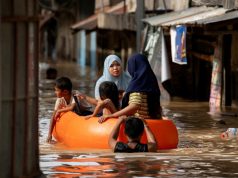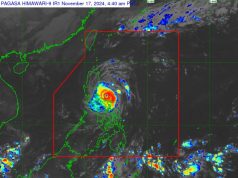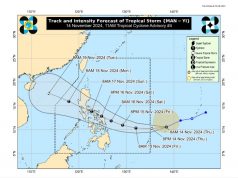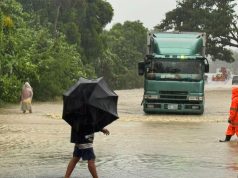
Is it time to change the years-old names of tropical cyclones?
This was what some Filipinos thought after news reports released the state weather bureau’s list of local names for tropical cyclones that would enter the Philippine Area of Responsibility (PAR) for 2023.
This year, the Philippine Atmospheric, Geophysical and Astronomical Services Administration (Pagasa) will use the following names:
| Amang | Goring | Marilyn | Sarah | Zigzag |
| Betty | Hanna | Nimfa | Tamaraw | |
| Chedeng | Ineng | Onyok | Ugong | |
| Dodong | Jenny | Perla | Viring | |
| Egay | Kabayan | Quiel | Weng | |
| Falcon | Liwayway | Ramon | Yoyoy |
The following, on the other hand, is the list of auxiliary names to be used if the tropical cyclones entering PAR have exceeded 25:
| Abe | Felion |
| Berto | Gening |
| Charo | Herman |
| Dado | Irma |
| Estoy | Jaime |
The list of names is under Pagasa’s third set of regular names for tropical cyclones to be used for the years 2023, 2027, 2031, and 2035.
Upon learning this, some Pinoys thought that the state weather bureau should change the names to make it sound more threatening, claiming that the assigned ones sounded “unserious.”
why are names of storms in the philippines so unserious 😭 https://t.co/4GZ2eoVZBH
— niki / kyrie ִֶָ 🌷 (@celesdere) January 9, 2023
“Eto isang rason kung bakit madaming namamatay sa bagyo dahil ayaw lumikas eh. ‘Yung pangalan ng mga bagyo ‘di kasi nakakatakot. Pangalanan mo mga bagyo ng ‘Super Typhoon Kamatayan 2000’ — baka isang linggo bago landfall eh magsilikas lahat ‘yan,” another Twitter user wrote.
“Do [you] think we have to step up in making up typhoon names, like, make the names sound a bit more terrifying like [sinong] [matatakot kay] Dodong [‘di ba]??” a different Pinoy commented.
“No [because] why would [you] name a typhoon Liwayway…..?????” another online user exclaimed. “Liwayway” refers to the rising of the sun in the morning, particularly when it starts exhibiting faint light in the sky.
What’s in a name
Naming storms have been a standard among weather bureaus.
According to the World Meteorological Organization, it is “easier for people to understand and remember the tropical cyclone in a region, thus to facilitate… disaster risk awareness, preparedness, management and reduction.”
Venus Valdemoro, former Pagasa public information unit chief, in an interview said that the state weather bureau chooses Filipino-sounding names to establish an effective recall among the public.
The United States’ National Oceanic and Atmospheric Administration said that “familiar names are more easily remembered in the rural areas” and that “having a Pagasa-assigned name helps to underscore the fact that the cyclone is within Pagasa’s AOR and potentially a threat to the Philippines.”
AOR refers to the Area of Responsibility or the monitoring domain in which a meteorological agency monitors weather occurrences.

“Since tropical and/or monsoon depressions can bring very heavy rainfall to the nation which often results in disastrous flooding, the weather service feels that assigning a name helps to enhance public attention given to a system,” NOAA said.
A report from Yahoo Southeast Asia noted that Pagasa launched a “Name A Bagyo” contest in 1998, asking Filipinos to submit all the names they want to use for storms that enter PAR.
A committee chose about 140 names from the nominations in 1999.
Valdemoro said that ever since the naming system formally took effect in 2001, the set of new names has not changed as of 2013.
They will also be repeated every four years, except if the storm has caused 300 or more deaths or left P1 billion or more damage in its wake.
If this happens, the name will be decommissioned or removed from its list of tropical cyclone names. Pagasa will then update the list to replace the old ones.
Valdemoro said that this is being observed to prevent psychological relapse or stop traumatic experiences from returning to people.
Before Pagasa launched a naming contest, the report said that the Philippines locally named storms after Filipino women ending with “-ng” or “-ing” like “Auring” and “Yayang,” specifically from 1963 to 2001.
This took effect after Australian weatherman Clement Wragge started giving female names to tropical cycles in the 1890s.









